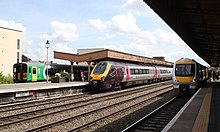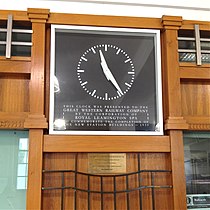Leamington Spa railway station
Leamington Spa | |
|---|---|
 Leamington Spa railway station exterior | |
| Location | Royal Leamington Spa, District of Warwick England |
| Grid reference | SP317652 |
| Managed by | Chiltern Railways |
| Platforms | 4 |
| Other information | |
| Station code | LMS |
| Classification | DfT category C1 |
| History | |
| Original company | Great Western Railway |
| Pre-grouping | GWR |
| Post-grouping | GWR |
| Key dates | |
| 1852 | Opened as Leamington[1] |
| 1913 | Renamed Leamington Spa[1] |
| 1937-39 | Rebuilt |
| 1950 | Renamed Leamington Spa General[1] |
| 1968 | Renamed Leamington Spa[1] |
| Passengers | |
| 2016/17 | |
| 2017/18 | |
| 2018/19 | |
| 2019/20 | |
| Interchange | 0.266 million |
| 2020/21 | |
| Interchange | |
| Location | |
 | |
| Notes | |
Passenger statistics from the Office of Rail and Road | |
Leamington Spa railway station serves the town of Royal Leamington Spa, in Warwickshire, England. It is situated on Old Warwick Road towards the southern edge of the town centre. It is a major stop on the Chiltern Main Line between London and Birmingham, and the branch line to Coventry.
History[]
The first station at the site, under the name Leamington was opened by the Great Western Railway (GWR) on its new main line between Birmingham, Oxford and London in 1852.[2] It was later renamed Leamington Spa in 1913.[1]
This was not the first station in Leamington; the London and North Western Railway (LNWR) had reached the town eight years earlier in 1844, with a branch line from Coventry. That line, however, terminated about 0.7 miles (1.1 km) from the town centre, at Milverton station. The opening of the GWR line compelled the LNWR to extend their Coventry branch into the centre of Leamington, and join it end-on to their new branch to Rugby, and in 1854 they opened a new station directly alongside the GWR station known as Leamington Spa (Avenue).[3] In 1864, a connection was made between the GWR and LNWR lines at Leamington, which was mainly used to exchange goods traffic.[2] The GWR station was often referred to as Leamington Spa General in order to distinguish it from the adjacent LNWR station, however it only carried this name officially between 1950 and 1968.[1]

James G. Batterson, the founder of American insurance giant The Travelers Companies, claimed that he first became aware of accident insurance in 1859 when he bought a railway ticket from this station to London which included accidental death insurance up to the amount of £1,000.[4]
In the 1930s the GWR took advantage of a government loan guarantee scheme to fund improvements to their railway network; one of these improvements was the complete rebuilding between 1937-39 of their station at Leamington in the then popular Art Deco style.[2][5]
The station came under the control of the Western Region of British Railways in 1948. In 1965 British Railways closed down the adjacent Avenue station and the branch to Rugby, and diverted the Coventry branch into the ex-GWR station via a new connection. Prior to this there had only been sidings connecting the Coventry line to the ex-GWR line, used for the exchange of goods wagons. BR also removed passenger services from the Coventry branch at the same time, and closed all of the intermediate stations, leaving it open for freight trains only. This lasted until 1977, when BR resumed passenger trains between Leamington and Coventry.[3]
In 1996, Chiltern Railways took over the running of the station and the London to Birmingham services, upon the privatisation of British Rail.[6]
In 2011 the two waiting rooms were restored and refurbished as part of £395,000 improvements that also include 80 new parking spaces at the front of the station and improved disabled access.[7]
The station building and platform structures became grade II listed buildings in 2003.[8]
The station today[]
Routes[]
Three lines radiate from Leamington Spa:
- one heading north-west to Birmingham by way of Warwick and Solihull, with a branch to Stratford-upon-Avon diverging at Hatton, some 6 miles (9.7 km) from Leamington;
- one going north through Kenilworth to Coventry;
- one heading south-east towards Banbury, beyond which it splits into routes heading for London (Marylebone) and for Reading, via Oxford.
Layout[]

The present art deco-style station, which dates from immediately prior to the Second World War (it was comprehensively rebuilt between 1937 and 1939), has four platforms which are numbered one to four from south to north. Platforms one and four are west-facing bays, used only by local trains to and from Birmingham Snow Hill, Stratford-upon-Avon or Nuneaton starting or terminating at Leamington. Platforms two and three are through platforms: platform two is used by services to Stratford-upon-Avon, Birmingham Snow Hill or Coventry, Birmingham New Street and beyond; platform three is for departures to Banbury and London Marylebone or Reading. Two central lines allow freight trains or other non-stop services to pass through the station when platforms two and three are occupied.
Services[]

Chiltern Railways[]
Chiltern Railways services run at frequent intervals (mostly half-hourly) between London's Marylebone station and Birmingham Moor Street (limited stop, alternate trains continue through to Birmingham Snow Hill); further trains (at approximately two-hourly intervals) travel from here to Stratford-upon-Avon and to Moor Street (stopping service). A number of the Birmingham trains start from Kidderminster in the mornings and terminate there in the evenings, whilst there is also a limited through service between Marylebone and Stratford-upon-Avon.[9]
On Sundays, the frequency of trains is in most cases about half of that indicated above, though the service to and from Stratford remains two-hourly.
CrossCountry[]
Two long-distance trains per hour, operated by CrossCountry, stop in each direction. Typically, these alternate between services on two routes: Manchester to Bournemouth (via Stafford, Birmingham New Street, Coventry, Oxford and Basingstoke) and Newcastle to Reading (via Doncaster, Sheffield, Derby and Birmingham New Street) with certain trains extended to/from Southampton Central.[10]
West Midlands Railway[]
West Midlands Railway operates peak-hour trains to Birmingham Snow Hill, Stourbridge Junction, Kidderminster and Worcester Shrub Hill at the beginning of the day and from there in the evening.[11] From May 2018, the company began operating an hourly local service to Coventry, calling at the reopened Kenilworth station; in May 2019, this was extended to Nuneaton.[12]
Motive power depots[]
The London and Birmingham Railway opened a motive power depot on the west side of the line at their Milverton station in 1844. It was replaced by a larger engine shed nearby in 1881, which was known as Warwick (Milverton). This depot closed 17 November 1958 and was demolished.[13] Locomotives were then serviced at the former Great Western Railway depot at Leamington Spa.
The Great Western Railway opened a motive power depot on the east side of the line south of Leamington Spa General Station in 1906. This was closed by British Railways 14 June 1965 and demolished.[14]
Gallery[]

Grade II listed station building

Reproduction Art Deco clock in the station booking hall
Station sign
References[]
- ^ a b c d e f Butt, R. V. J. (1995). The Directory of Railway Stations: details every public and private passenger station, halt, platform and stopping place, past and present (1st ed.). Sparkford: Patrick Stephens Ltd. p. 140. ISBN 978-1-85260-508-7. OCLC 60251199.
- ^ a b c "Leamington Spa Station (GWR)". Warwickshire Railways. Retrieved 24 May 2020.
- ^ a b Hurst, Geoffrey (1993). LNWR Branch Lines of West Leicestershire & East Warwickshire (First ed.). Milepost Publications. pp. 44–59. ISBN 0-947796-16-9.
- ^ "The Travelers' Fortieth Anniversary". Insurance Monitor. New York: C.C. Hine's Sons Company. 52 (4): 160–162. April 1904.
- ^ Hendry, R. Preston; Hendry, R. Powell (1992). Paddington to the Mersey. Oxford Publishing Company. pp. 139–143. ISBN 9780860934424. OCLC 877729237.
- ^ "Railways to Leamington Spa" (PDF). Leamington History Group. Retrieved 26 May 2020.
- ^ "Leamington Spa railway's 1930s waiting rooms restored". BBC News. 3 May 2011. Retrieved 26 May 2020.
- ^ Historic England. "LEAMINGTON SPA STATION, INCLUDING ATTACHED PLATFORM STRUCTURES (1390496)". National Heritage List for England. Retrieved 9 February 2019.
- ^ GB eNRT December 2015 Edition, Tables 71 & 115
- ^ GB eNRT December 2015 Edition, Table 51
- ^ GB eNRT December 2015 Edition, Table 71
- ^ "When direct trains from Nuneaton and Leamington start". Coventry Telegraph. 18 May 2019. Retrieved 25 May 2020.
- ^ Roger Griffiths and Paul Smith, The directory of British engine sheds:1 (Oxford Publishing Co., 1999), p.154. ISBN 0 86093 542 6.
- ^ Roger Griffiths and Paul Smith, The directory of British engine sheds:1 (Oxford Publishing Co., 1999), p.154. ISBN 0 86093 542 6.
External links[]
| Wikimedia Commons has media related to Leamington Spa railway station. |
- Train times and station information for Leamington Spa railway station from National Rail
- Solihull and Leamington Rail Users Association – representing the interests and views of local rail users
- Historical photographs of the GWR Leamington Spa station
| Preceding station | Following station | |||
|---|---|---|---|---|
| Warwick | Chiltern Railways London to Birmingham |
Banbury | ||
| Chiltern Railways Leamington Spa–Stratford |
Terminus | |||
| Coventry | CrossCountry Manchester-Bournemouth |
Banbury | ||
| Birmingham New Street |
CrossCountry Leeds/Newcastle–Southampton Central/Reading |
|||
| Warwick Limited Service |
West Midlands Railway Leamington Spa to Worcester |
Terminus | ||
| Kenilworth | West Midlands Railway Coventry-Leamington line |
Terminus | ||
Coordinates: 52°17′05″N 1°32′11″W / 52.2846°N 1.5363°W
- Buildings and structures in Leamington Spa
- Railway stations in Warwickshire
- Former Great Western Railway stations
- Railway stations in Great Britain opened in 1852
- Railway stations served by Chiltern Railways
- Railway stations served by CrossCountry
- Railway stations served by West Midlands Trains
- Grade II listed railway stations
- Grade II listed buildings in Warwickshire
- Art Deco railway stations
- Art Deco architecture in England
- 1852 establishments in England
- DfT Category C1 stations



